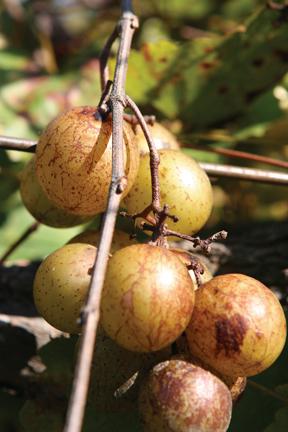GRAPE EXPECTATIONS: U-Pick Vineyards Await Arrival Of Muscadine Season

It’s hard not to laugh as you watch Dr. Arlie Powell demonstrate the fine art of eating a muscadine. But the horticulture professor emeritus from Auburn University is dead serious about the technique Southerners mastered long ago:– Step one, place muscadine in the center of your mouth and crush it with your tongue.– Step two, using tongue, separate muscadine skin from the seed and the grape.– Step three, after enjoying the juice, remove seed and skin from your mouth.”You can be very polite and take it out of your mouth or you can spit it out,” Powell was saying. “But there is definitely a unique way to eat the fruit and enjoy it. Now, the average person in California says, ‘Gosh, that’s too much work! Just give me a Thompson seedless.'”That’s what Ken Barber — who IS from California — used to think. Not anymore. Today, you’ll find Barber as excited about the arrival of this year’s muscadine crop as Powell. That’s because both — Barber at Barber Berry Farm in Elmore County and Powell at Petals from the Past in Chilton County — have now opened their respective u-pick vineyards to throngs of muscadine pickers.In Alabama, fall may mean it’s time for kickoff, but for muscadine lovers, it also means the fruit is ripe for the picking, usually right up until first frost. According to the Alabama Farmers Market Authority’s Web site at www.BuyLocalAlabama.com, 21 u-pick operators in 17 counties list muscadines among their produce.That, of course, doesn’t include the countless arbors growing in back yards or those vines growing wild in woodlands across the state.
While the muscadine is indigenous to Alabama, it was first discovered in North Carolina in 1524 by Italian explorer Giovanni da Verrazano.Since then, Southern horticulturists have worked to develop at least 200 varieties, not the least of which is the oft-misunderstood bronze-colored scuppernong variety. “To some people, muscadines are dark colored and a scuppernong is anything that’s bronze colored,” said Powell, who tries to explain that scuppernong is only one variety of muscadine.Today, two of the more popular varieties are Pam and Darlene, both of which were developed by Ison’s Nursery & Vineyard in Brooks, Ga., and named after two Ison daughters.Still, as numbers go, Alabama’s muscadine production isn’t that large — Powell estimates 150-200 acres at best with most vineyards covering one to five acres. Powell’s muscadine vines cover less than an acre at Petals from the Past in Jemison; Barber Berry Farm near the Alabama River toll bridge has 11, 250-foot rows.”I think they’re a little like boiled peanuts in that the farther north you go, fewer people know about them,” said Farmers Market Authority Director Don Wambles, who has childhood memories of eating himself sick on “bulleses” as they called muscadines in Pike County. “People up North think boiled peanuts are nasty, but they’re a delicacy to us.”Barber himself had never heard of muscadines until 1992 when he was transferred by the Air Force to Alabama. “My mom says I took my first steps at Knott’s Berry Farm,” says Barber. “So blackberries are in my blood, but I’d never heard of muscadines until then. When I finally tasted some from a store, and it was — eehh? — they just weren’t all that exciting, not like the Thompson seedless grape you just throw in your mouth.”Then, on an Alabama Farmers Federation horticulture tour of an Opelika vineyard operated by the late Robert Weed, Barber quickly understood Southerners’ love for this thick-skinned, large-seeded grape. “Those things were good!” Barber exclaimed.Not long afterward, he planted his first rows, and pickers to his farm this year will be claiming its first fruits. In late July, he counted about 400 subscribers to the farm’s e-mail list. “And they’re waiting,” he said. “They want to know when the muscadines are going to be in.”Powell’s muscadine vineyard is 8-years-old, and loaded. He guesses this year will yield 3,000 to 5,000 pounds, a good portion of which will undoubtedly end up in an assortment of baked goods, jams, jellies and, yes, even homemade wine.
“The vast majority of them come in to eat them fresh, but there are quite a few — an increasing number — who put them up,” said Powell. “I thought canning and freezing and all that stuff was going out of style. But the Buy Fresh, Buy Local has turned this thing all the way around. My wife is helping me teach a class on preserving, and we partner with Extension. And people have come back… I could not believe it! I thought it was old hat.”But, Powell points out, there’s nothing quite like spending a nice fall afternoon in a pretty vineyard, picking and eating muscadines to your heart’s content.”Muscadine is one of those fruits that people really come out and pick and enjoy it,” Powell said. “It’s one of those where the guy laughs when he comes in with his container of muscadines and says, ‘You should’ve weighed me before I went out there!'” … When you walk out there to pick muscadines, it’s not work — it’s an absolute pleasure to enjoy being in a nice planting and picking all the fruit you want. It’s like going out there and casting a line and paying to catch a trout.” For more information about Barber Berry Farm, visit www.BarberBerryFarm.com or call (334) 549-4710. For more information about Petals from the Past, visit www.PetalsFromThePast.com
or call (205) 646-0069. For a list of Alabama u-pick operations, visit www.BuyLocalAlabama.com
.
